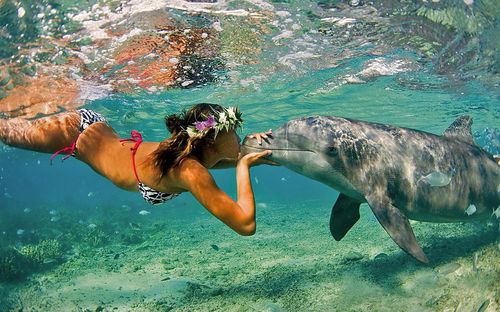Swimming!
Hello Mr. Big Teeth, Welcome To The Lineup!
At PISMO beach Ca we flew out at 9:15am and wanted to get some surfers on a DJI phantom 3 ...but saw a 10ft shark instead!! For any licensing requests please contact licensing@break.com
Fish On Fridays.
Batoidea is a superorder of cartilaginous fish commonly known as rays and skates, approximately 560 described species in thirteen families. They are in the fish subclass Elasmobranchii, along with sharks, to which they are closely related. Rays are distinguished by their flattened bodies, enlarged pectoral fins that are fused to the head, and gill slits that are placed on their ventral surfaces.
Fish On Fridays. "Hello Mr. Big Teeth!" (moving pictures)
[youtube http://www.youtube.com/watch?v=b2obQ4kTNcc]
Nothing like being up close and personal. Mommy!
Monday Morning Mermaid.
Marine Life Monday.
Hello, Mr. Big Teeth! Robot "Interacts" With Sharks. (Moving Pictures)
//player.vimeo.com/video/101165012
REMUS SharkCam: The hunter and the hunted from Woods Hole Oceanographic Inst. on Vimeo.
Hey, this doesn't taste like chicken!
Fish On Fridays. Black Tip Reef Sharks And A Wahine. "Swimming With The Sharks."
Taxonomy
The blacktip shark was first described by Valenciennes in Muller & Henle (1839) as Carcharias (Prionodon) limbatus. It has also appeared in the literature as Carcharias (Prionodon) pleurotaenia, Carcharias microps, Carcharias (Prionodon)muelleri, Carcharias maculipinna, Carcharias ehrenbergi, Carcharias aethlorus, Gymnorrhinus abbreviatus, Carcharias phorcys, and Carcharhinus natator. The currently valid scientific name is Carcharhinus limbatus (Müller and Henle 1839). The genus name Carcharhinus is derived from the Greek "karcharos" = sharpen and "rhinos" = nose. The species name "limbatus" originates from Latin, meaning bordered in reference to the black markings on its fins.
Common Names
The blacktip shark gets its name from its distinctive black markings on the tips of its fins. It is also known as blackfin (Guam, Micronesia, Trinidad and Tobago), black-tipped (Papua New Guinea), small blacktip (Cuba, Leeward Islands), and spot-fin ground shark (UK).
Geographical Distribution
Blacktip sharks are cosmopolitan in tropical to subtropical coastal, shelf, and island waters. In the Atlantic during their seasonal migration they range from Nova Scotia to Brazil, but their center of abundance is in the Gulf of Mexico and Caribbean Sea. They occur throughout the Mediterranean and along the central West coast of Africa. In the Pacific they range from Southern California to Peru, including the Sea of Cortez. They occur at the Galapagos Islands, Hawaii, Tahiti, and other South Pacific Islands, to the North coast of Australia. In the Indian Ocean they range from South Africa and Madagascar up to the Red Sea, Persian Gulf, throughout India's coast, and east to the coast of China.
World distribution map for the blacktip shark
Habitat
The blacktip shark inhabits inshore and offshore waters, but is not a truly pelagic species. They are often seen nearshore around river mouths, bays, mangrove swamps, and in other estuaries, though they do not penetrate far into freshwater. They can be found offshore and over deep waters near coral reef dropoffs, but primarily stay in the upper 100 feet (30 m) of the water column.
A young blacktip shark cruises the Caribbean shallows
© Jeremy Stafford-Deitsch

Hello Mr. Whale, How's Your Summer (Winter...Southern Hemisphere) Going? Kayak Levantado Por Ballena (Moving Pictures)
[youtube http://www.youtube.com/watch?v=iRmrQGHhdCM]
I know, why don't I give a couple of clueless humans a scare.
Yes boys and girls, you're not living in a pretend world. Wild animals do whatever the heck that want.
Maybe, I Should Rethink Using My Inflatable Kayak. "Yikes!" (Moving Pictures)
[youtube http://www.youtube.com/watch?v=SCUc3U8WVMo]
Is that the lunch bell ringing?
Mommy!
Surfing Photo Of The Week. Surfing Whales!
There are a couple of new guys in the line up.
Stick, I don't need no damn stick brah!
Hat tip Mark Denzer
Source: Divine Dolphin
Credit: North Shore Surf Photos
Massive Dolphin Stampede. (Moving Pictures) (Wow On Wednesday)
[youtube http://www.youtube.com/watch?v=Bo_f8mV5khg]
Wow!
Dave Anderson of Capt. Dave’s Dolphin and Whale Safari used a drone to capture this remarkable footage of dolphins, and gray whales migrating off the coast of Southern California, and a humpback whale off of Maui snuggling with her calf.
There's A New Guy In The Lineup, And He Personifies "Locals Only!" (Surfing)
Locals can be intimidating.
A 13-foot crocodile decided to paddle out for a surfing session. For some reason, his appearnce closed down Cable Beach, near Broome Australia, this past Saturday.
"He was a big boy — his head was huge," said local photographer Sharon Scoble, who snapped the incredible images of the surfing reptile.
Read more at Mensup.fr
Aloha Friday.
Marlin Monday.
Hello, Joe! What do you know?
Via Marlin Magazine's facebook page | Photo by Martin Firestein, slightly altered by me.
Marine Life Monday.
[youtube http://www.youtube.com/watch?v=GDwOi7HpHtQ]
More zanniness from the mind of Ze Frank. Today he takes us on a journey of discovery about the Cuttlefish.
Fish On Fridays.
Have A Great Weekend!
Fish On Fridays. "Mr. Big Teeth Says Hello." (Moving Pictures)
[youtube=http://www.youtube.com/watch?v=hYxmVGhabRk&w=480&h=270]
Mommy!
What's For Lunch? (Marine Life) (Moving Pictures)
[youtube=http://www.youtube.com/watch?v=7d4A__P0XEk&w=480&h=270]
Note to self: don't get in the way of hungry whales and their food.
Via Tim Zimmerman, Writer












